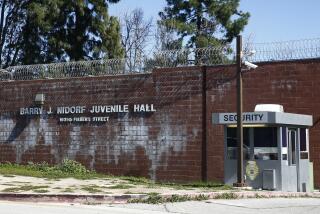‘Fruits of Crime’ Bring Police Money Bonanza : Confiscated Cash, Cars, Boats, and Planes Are Used by Departments in War on Lawbreakers
It started as a high-speed chase through North County’s highways. Pursuing officers weren’t having much success in halting the suspect, who was driving a $60,000 Porsche 930 Turbo Carrera, until he lost control and crashed.
The suspect was uninjured and attempted to escape on foot, grabbing a briefcase from the car’s seat before he fled. Luck was on the side of the law that day, however, and the briefcase flew open, scattering a blizzard of currency and leaving a paper trail for pursuing officers to follow. Both man and money were taken into custody.
Now, more than two years later, the San Diego Sheriff’s Department is awaiting a government check for their share of the $237,000 the suspect was carrying. The money was forfeited by the suspect because authorities determined it to be “fruits of crime,” or profits from drug trafficking.
Money, cars and property that authorities say are the proceeds from the nation’s multibillion dollar illegal drug industry are expected soon to provide local law enforcement with its biggest windfall since the creation of the tax system. An 18-month-old federal law authorizes local agencies to keep as much as 80% of the assets seized from drug traffickers.
California also has a drug trafficking forfeiture procedure but most police departments have stopped using it. Under national law, they can recoup a larger share under the federal program of the drug monies seized.
But this boycott, in effect, of the state program now threatens two drug prevention programs that are funded with forfeited drug money and bills before the Legislature would make state procedures more competitive and, hopefully, save the prevention programs.
The federal forfeiture program has been given major emphasis by the Reagan Administration, which pushed for passage of the 1984 Comprehensive Crime Control Act, said Brad Cates, director of the Department of Justice asset forfeiture office.
The legislation authorized the federal government to share drug forfeitures with local police departments that participate in joint investigations with agencies such as the Drug Enforcement Agency and the FBI.
“Forfeitures are a way to bring total justice to a criminal case,” Cates said. “People get tired of seeing a guy walk away with one or two years in prison. When you confiscate money, cars, planes or a ranch, people feel that justice is being served.”
Since the program began, San Diego County law enforcement agencies have filed claims for more than $10 million in cash seized in raids and have shared in forfeited items that range from expensive sports cars and estates to travel-worn trucks and shotguns.
The plum now coveted by the San Diego City Police Department is a helicopter. But the U.S. Drug Enforcement Agency has first dibs on the craft and the local law enforcement agency which participated in the seizure has second claim. SDPD, which had no part in the operation, must wait its turn.
One federal officer, noting San Diego’s bid on the whirlybird, commented: “They’d be better off without it. It takes a lot of money to maintain a helicopter. A $3 million machine and it takes, maybe, $9 million to keep it in operation.”
Sheriff’s Lt. Alan Fulmer, division commander of the multiagency Narcotics Task Force, said the San Diego Sheriff’s Department has received an automobile, a light airplane and a sizable amount of video and electronic monitoring equipment under the federal seizure and forfeiture program. So far, Fulmer said, the county hasn’t received any of the “several million dollars” in cash it claims as its share of confiscated drug monies.
Plans for Money
“I guess they’ve got a lot of paper work to do in Washington,” Fulmer said, “and the money is coming in a little slow.” But when it does show up, he said, it will probably go toward the department’s project to connect up with a sophisticated new statewide fingerprint identification system--a system credited with catching the suspected Night Stalker killer.
“There’s not much infighting over the stuff that is seized,” Fulmer said. “There’s plenty to go around.”
The federal law requires only that the money received through the program be used for law enforcement purposes and not as replacement of normal budget funds.
In National City, where “several tens of thousands of dollars” in drug traffickers’ forfeited cash has been applied for, Capt. Wayne Fowler explained that the Police Department won’t get to see the money. “It goes directly to the city, into the general fund, and the city decides what it is to be used for.
National City decided against claiming several seized autos, Fowler said, but did pick up “a couple of serviceable weapons” under the federal program.
Oceanside, Escondido, El Cajon and several other San Diego County cities have pending claims on cash seized in drug busts, and have shared in distribution of seized property and assets, according to Marlo Mosier of the U.S. marshal’s office.
During 1985 and the first two months of this year, Los Angeles Police Department investigators have seized more than $20 million in drug-related money, while the drug teams of the Los Angeles County Sheriff’s Department have seized between $3 and $4 million during the same period, department officials said.
The federal Justice Department has received more than 600 applications to share in the estimated $350 million of drug money and assets seized nationwide since the procedure for local police agencies to apply for a share in drug forfeiture proceeds was established in August of last year, program director Cates said.
Contested Cases
About 10% of the forfeiture cases are contested in federal court by those who claim the money and assets were earned legitimately, Cates said. Though small in number, those cases involve about half of the total value of seizures made, he said.
The federal hearings are held to determine whether or not the seized assets were proceeds from drug trafficking, used in the transportation of drugs or in some way facilitated a drug enterprise, Cates said. The hearings are separate from any criminal hearing, he said.
The civil hearings in federal court carry a less strict burden of proof than the forfeitures under California law.
“The state requires a criminal conviction, so it must be proved beyond a reasonable doubt,” said Los Angeles Deputy Dist. Atty. Eldon Pritikin, who handles forfeiture cases for police agencies throughout the county.
“Under the federal law, the burden of proof is a preponderance of evidence. You can even use hearsay in the testimony,” Pritikin said.
Federal agencies such as the DEA and FBI can process forfeiture cases from seizures made during local police investigations, although the federal law was designed to prevent local agencies from bypassing the state forfeiture procedure simply to collect greater revenues.
In Los Angeles County, requests for state forfeiture money has dropped from $3.3 million in 1984, to $1.2 million last year, district attorney records show. This year, Pritikin said, no agency has filed for reimbursement from the state.
The main reason local agencies are avoiding the state program, officials say, is because the state pays local agencies only the direct costs of conducting the investigation.
Local law enforcement officials agree that they get a better deal from the federal forfeiture program than the state’s.
Differences in Programs
Cars, for example, are sold by the state after a criminal conviction and the proceeds are used to repay police departments. Under federal law, agencies can keep the vehicles and use them for undercover work.
Statewide, fewer and fewer local agencies are filing requests for reimbursement through the state program, said Brian Taugher, special assistant to the Attorney General.
“The state forfeiture law is universally viewed by law enforcement as ineffective,” Taugher said.
That assessment worries state officials who use the bulk of the state’s drug forfeiture money to fund drug prevention programs and a statewide mental health program for elementary school children.
The state Narcotics Assistance and Relinquishment by Criminal Offender (NARCO) fund, which shares half of the state forfeiture fund and is used to provide grants to local enforcement agencies for drug programs, has dropped from a 1984 total of $442,000 to the current balance of $111,000, Taugher said.
And a state mental health program funded by seized drug assets and designed to help kindergarten through third-grade elementary students stay away from drugs may also be jeopardized by the decline in state forfeiture requests.
“We don’t know how it might effect us,” said program director Fran Church. “We haven’t seen any drop in funds yet, but it takes a long time for the money to get processed.”
State Assemblyman Gary Condit (D-Modesto) has introduced a bill that would amend the state forfeiture law to more closely resemble the federal law. For example, it would remove the current requirement that a drug trafficker be convicted before assets can be taken.
More to Read
Sign up for Essential California
The most important California stories and recommendations in your inbox every morning.
You may occasionally receive promotional content from the Los Angeles Times.










